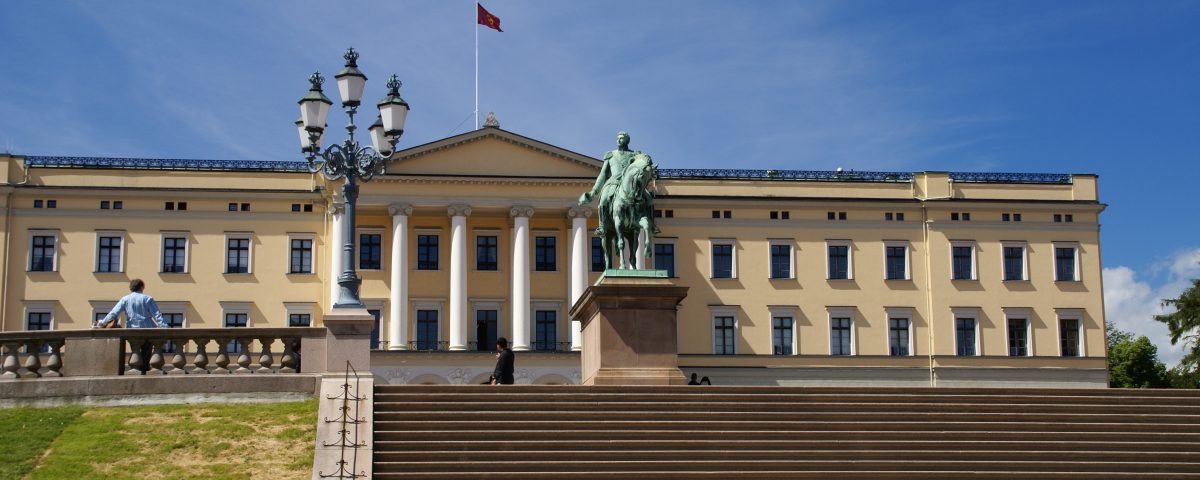Top 7 things to do in Oslo
Tourists will never fail to get mesmerized by the beauty of the Norwegian capital. We have gathered some of the best Scandinavia’s oldest capital city has to offer, so you can get the most out of your visit. These are our top things to do in Oslo.
1. Oslo Opera House
The world’s first – and only – opera house which you can walk up onto the roof, is located in the Norwegian capital. Which is reason enough to be included in our favourite things to do in Oslo. Even though it may not look all that impressive from distance, it will leave you spellbound. Oslo Opera House is fast becoming one of the iconic modern buildings of Scandinavia, and it does not come as a surprise.
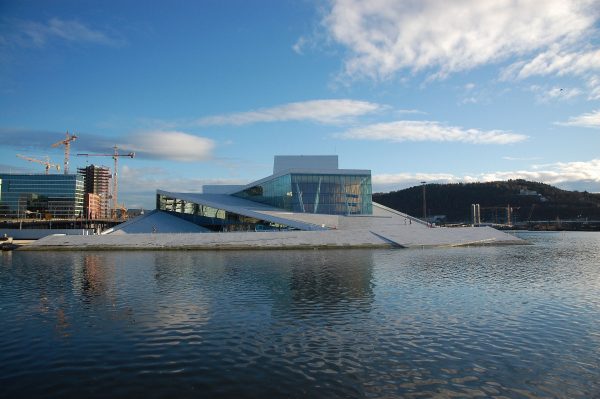
Photo: Operahuset by Anne-Sophie, licensed under (CC BY 2.0)
Appearing to rise out of the waters of Oslofjord like a glacier, clad in Italian marble and white granite, the Opera sparkles. Apart from being one of Norway’s most impressive examples of contemporary architecture, it is also the home of the Norwegian National Opera and Ballet as well as the National Opera Theatre.
The interior is equally interesting, with large windows flooding the foyer with light and offering glimpses of the dominating feature – the Wave Wall. Made of strips of golden oak, the wall curves up through the centre of the foyer and provides access to the upper levels of the building. To see more of the interior you can join one of the guided tours. This guided tour allows you to take a look into some of the building’s 1100 rooms. The guide will explain much of the artistic symbolism of the building, and reveal something of life behind the scenes at the Opera House.
While wandering around and inside the building, it can be easy to forget that it’s not just there to serve as eye candy for tourists. The Oslo Opera Houses prime role is to act as a showcase for world class opera and ballet performances. Be sure to check out the upcoming performances. You can buy tickets on their website.
2. Holmenkollen
Perched on a hilltop overlooking Oslo, The Holmenkollen Ski Jump offers a panoramic view of the city During Oslo’s annual ski festival. The ski festival is held in March, and it draws the world’s best ski jumpers. You don’t have to be a dare-devil ski jumper to visit. The complex is well worth a visit thanks to its ski museum and a couple of other attractions. These attractions include such as the Holmenkollen Chapel and the Kragstøtten sculpture.
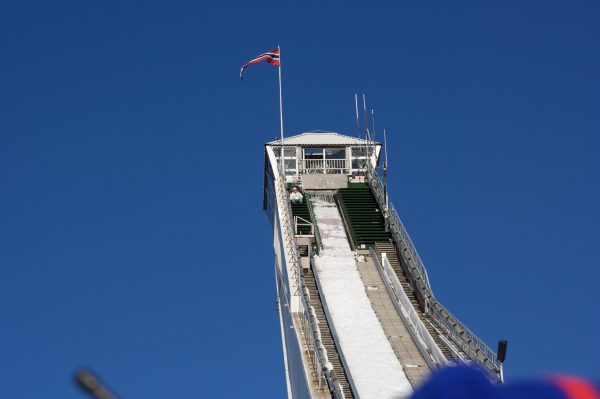
Photo: Holmenkollen by Håvar og Solveig, licensed under (CC BY 2.0)
Holmenkollen Ski Museum was founded in 1923 and is the oldest ski museum in the world. It leads you through the 4000-year history of Nordic and downhill skiing in Norway, starting with prehistoric times, with a range of fascinating exhibits.
The main features of the museum are galleries devoted to the topics of winter Olympics, the Antarctic expeditions of Amundsen and Scott, as well as Fridtjof Nansen’s slog across the Greenland icecap. A popular part of the Museum is the ski simulator, which allows visitors to experience the feel of jumping from Holmenkollen Ski Jump. It is good for a laugh, but don’t try it if you have a weak stomach.
3. The Ekeberg Restaurant
Located in the hills just above Oslo, Ekebergrestauranten will give you a stunning view of the inner Oslofjord, the city and Oslo Opera House. The restaurant is an early example of functionalist architecture, built in 1929. After falling into disrepair in the 1980s, the restaurant was renovated and reopened with a classy menu and a slick bar.
The cuisine at Ekebergrestauranten is a blend of the modern and the classic. During the summer months the restaurant welcomes you with a beautiful outdoor service. You can make reservations in both the main restaurant and upstairs in the Fine Dining Veranda, on the second floor.
In addition to the restaurant, Ekeberg is known for its 25 acre National Heritage and sculpture park. Here you will find 31 sculptures, many of which have women as the subject. Next to the sculpture park, in an 1891 white Swiss chalet style villa, is an indoor museum. The museum describes the nature and history of Ekeberg, and is the base of the park. It offers art workshops, guided tours, and outdoor activities.
4. Vigeland Sculpture Park
With more than a million visitors annually, the iconic Vigeland Park is the most popular attraction in Norway. Open year round, this park is an extraordinary open-air showcase of work by Norway’s best-loved sculptor, Gustav Vigeland. It contains more than 200 of his dynamic sculptures in bronze, granite and wrought iron.
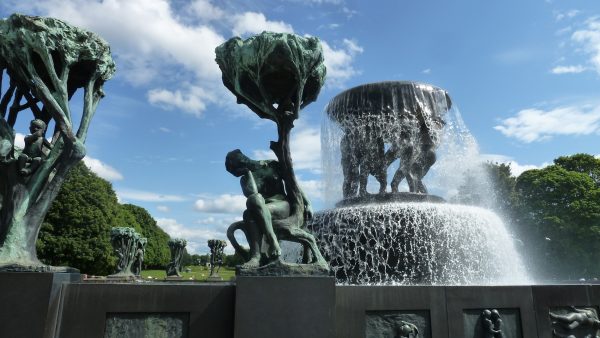
Photo: Vigelandsparken by mertxe iturrioz, licensed under (CC BY-SA 2.0)
Vigeland was in charge of both the design and the layout of the park, placing the majority of sculptures in five themed groups along a 2,800 ft long axis. His work ranges from entwined lovers and tranquil elderly couples to contempt-ridden beggars. His most renowned work, Little Hot-Head, portrays a London child in a mood of particular ill humour. Still, the most impressive one is the 55 foot high Monolith comprising 121 intertwined human bodies.
For an in-depth look at Gustav Vigeland’s work, you can visit the Vigeland Museum which was built by the city in the 1920s as a home and workshop for the sculptor. It contains his early collection of statuary and monuments to public figures, as well as plaster moulds, woodblock prints and sketches. The museum was opened to the public four years after he died in 1943. Guided tours are available in English, with prior notice.
Vigeland Park is actually a part of Frogner Park which attracts locals with its broad lawns, ponds, stream and rows of shady trees. The park is ideal for picnics, sunbathing and lounging on the grass or strolling the beautiful grounds.
5. The Royal Palace
The Royal Palace is located at one end of Oslo’s main streets, Karl Johans gate, right in the heart of the city. The beautiful neoclassical building was built for King Carl Johan, who died before it was finished in 1849. The Palace is the most important of the King’s residences, and most official functions take place here.
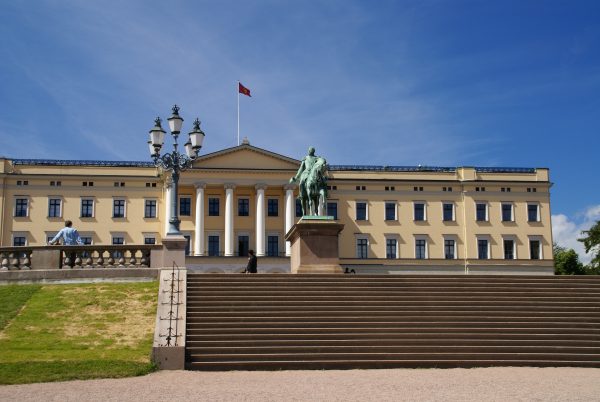
Photo: Slottet by Ryan Mallady, licensed under (CC BY-SA 2.0)
The impressive 173-room building is open to the public during the summer, and all visitors must follow a guided tour. The tours last about one hour and tours in English are given every day. We recommend buying tickets online beforehand, as only a few tickets are available at the door. Visitors are also free to wander the grounds and gardens or watch the regular changing of the guard.
Although the Norwegian monarchy goes back many centuries, modern Norway as an independent nation is relatively young. Merged under a single monarch with Denmark in 1380, and dissolving in 1814 in the aftermath of the Napoleonic Wars, Norway stayed an independent nation for just a few months. Norway was compelled to enter into a union with Sweden with a common king and joint foreign policy. In 1905 the union was dissolved, and Norway got to chose its own monarch.
6. The Well
Just outside of Oslo city centre you will find one of Scandinavia’s largest wellness centre and spa – The Well. With its 10,500 square metres, it is a wonderful paradise for adults, offering unique experiences, both indoors and outdoors.
The Well has 11 different pools, 15 different saunas and steam rooms. The wellness centre and spa also offers more than 100 showers, waterfalls, a Japanese bathhouse, Oriental Hammam, rhassoul clay treatments, a restaurant and much more. The outdoor area features a large swimming pool, two whirlpools and a sauna built in a rustic style, nestled among rocky outcrops and pine trees.
7. Play golf at Losby Golf Course
Just 20 minutes from the city centre you will find the luxurious Losby Gods. The manor has 160 years of history and is surrounded by magnificent nature and has a harmonic atmosphere. Losby Manor’s main attractions are the two golf courses: Østmork the 18 hole championship course and Vestmork the 9 hole course. They are both designed by the renowned golf course architect, Peter Nordwall.
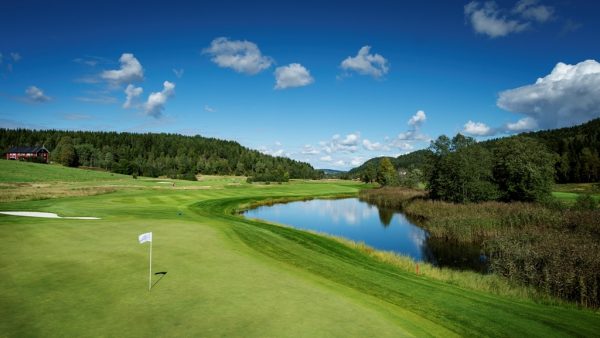
Perfectly integrated alongside the meandering path of the Losby River that runs through the valley, the championship course combines both size and quality of the greens. Vestmork compliments the championship course perfectly, and with its compact and challenging design is a worthy alternative for those who wish a ‘quick nine holes’.
Stay at Losby Gods in Oslo
The luxurious Losby Gods, which was featured in an episode of the 13th season of The Bachelorette, offers two exclusive and romantic bachelorette-packages that allows couples to cultivate love.
Choose between The Romantic Luxury Package which offers Losby Gods very best room – The Haakon Suite. The suite is located in the oldest part of the estate. Built in 1850, the suite later got its name after King Haakon VII. King Haakon VII ruled in Norway from 1905 to 1957. It includes both a hot tub and sauna, and has large window facing the fountain in front of the main entrance of the manor. From the balcony you can enjoy the magnificent view of the beautiful garden, idyllic nature and the golf courses. This is one of Norway’s finest. The other option, The Standard Bachelorette Package, includes a Deluxe Room with a balcony view. Extend the morning with breakfast in the king-sized bed.
If you want to experience all the amazing things to do in Oslo, you can stay at Losby Gods without booking one of the Bachelorette-packages. There are many other options for ordinary rooms that can be booked for as many nights as you wish.
